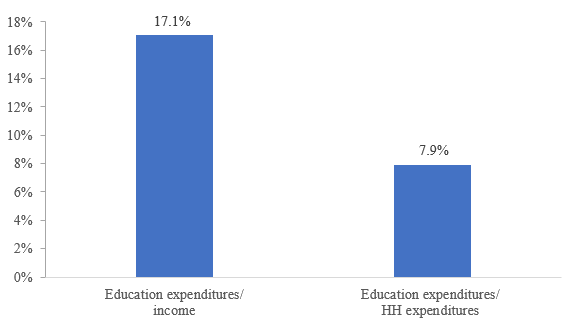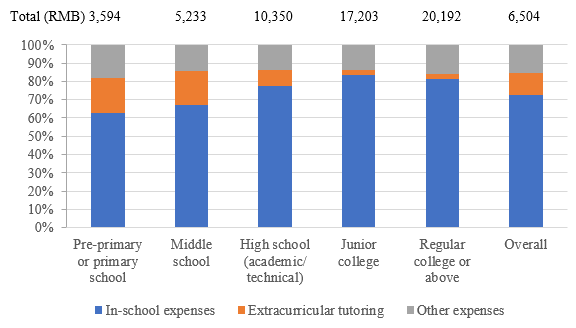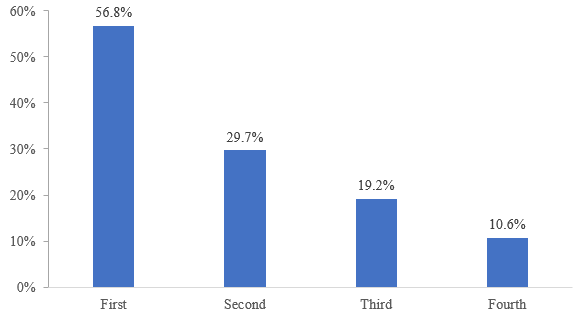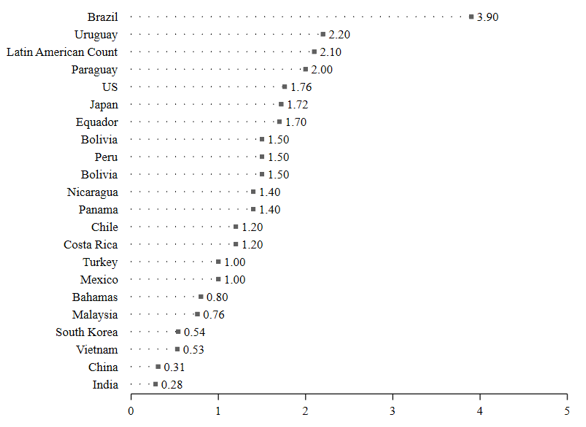The Burden of Education Costs in China: A Struggle for All, but Heavier for Lower-Income Families
This study examines the level and equity of household education spending in China using representative microdata. We find that education expenditures constitute a substantial portion of household income, averaging around 17.1%, and in-school expenses constitute the majority of education costs (73%), contrary to the focus on tutoring in media and policy discussions. Moreover, there is an inverse relationship between household income and the fraction of income spent on education, with the top quartile spending 10.6% of income on education and the bottom quartile spending a staggering 56.8%. Regression analysis indicates an income elasticity of 0.306, implying that education is a necessity good in China. These results underscore the excessive financial burden imposed by education expenditures, particularly on families in the lower income bracket. It is imperative to implement effective public policies in China that improve the affordability of education for a broader segment of the population.

The elevated costs of education in China have garnered substantial media coverage (NBC News 2013, Reuters 2021, Zhou and Tan 2021). Families in China allocate a significantly larger proportion of their expenditures to children’s education when compared to families in other countries. It is perplexing that these costs remain high despite the Chinese government’s substantial increase in education spending to over 4% of GDP since 2012, which is in close proximity to the global average of 4.3% (Figure 1). Moreover, the government has recently taken steps to curb costs for families with children by banning private tutoring, an industry that reached billions of dollars in value (Stevenson and Li 2021, Reuters 2021). However, despite the attention these policy changes and media reports have received, there exists a notable gap in our understanding of education expenses in China, particularly with regard to comprehensive empirical investigations employing nationally representative data.
Figure 1: Government spending on education in China

To fill this gap, our new study (Hu et al. 2023) investigates the level of household education expenditures in China using data from the nationally representative China Family Panel Studies (CFPS) dataset. Our analysis aims to quantify the total education expenditure and assess its proportion in relation to household income. Additionally, we explore how the financial burden of education varies across different income levels. To further understand the nature of children’s education in China, we employ regression models with a log-log specification to estimate the income elasticity of education expenditures. This estimation provides insights into whether education is considered a luxury or a necessity good in the context of Chinese families.
Main findings
We construct a sample of households consisting solely of parents and their children. Each household has at least one child aged 25 or younger who is currently attending school. Our empirical analysis yields several important findings. Firstly, household education expenditures in China are remarkably high, with an average of RMB 8,464 (USD 1,207) per year, accounting for 17.1% of total household annual income (Figure 2). While we lack income data for other countries, we can compare the percentage of household expenditures spent on children’s education. When compared internationally, we alternatively restrict the sample to households with and without children and find that the percentage of expenditures on education in total household annual expenditure in China stands at 7.9%, surpassing that of other countries (Figure 3). For example, Japan, Mexico, and the United States typically allocate only 1% to 2% of household expenditures toward education. While Korea’s share of 5.3% ranks second, it falls significantly short of China’s share.
Figure 2: China’s high household education costs

Figure 3: Percentage of household expenditures spent on education by country

Secondly, a detailed breakdown of education expenditures reveals that in-school expenses constitute the majority of these costs, contrary to the focus on tutoring in media and policy discussions. Specifically, 73% of the total expenditure is allocated to in-school expenses, while 12% is dedicated to extracurricular activities and tutoring. In-school expenses encompass tuition, books, after-school programs, food, and accommodation, as well as fees related to school-selection, uniforms, physical examinations, school medical insurance, and other items. Additionally, total education expenditure increases as children progress through different schooling stages, ranging from RMB 3,594 in pre-primary or primary school to RMB 20,192 in regular college or other higher education (Figure 4). Generally, as children advance to higher schooling stages, a larger proportion of expenses are attributed to in-school costs, while a smaller portion are allocated to extracurricular activities and tutoring.
Figure 4: Education expenditures per child and their components at different stages of education

Thirdly, we find that the share of education expenditures in household income increases as one moves down the income distribution. In China, families in the highest income quartile allocate 10.6% of their income to children’s education. However, what is even more striking is that families in the lowest income quartile spend a significantly larger proportion of their income (56.8%) on education, leaving very little for other expenditures (Figure 5). Most of these burdensome expenses are not attributed to private tutoring but rather to in-school costs, which is ironic considering that the majority of schools in China are publicly funded and provided.
Figure 5: Share of education expenditures in household income by income

Our final finding emphasizes the status of education as a necessity in China. We estimate the income elasticity of education expenditures in China to be 0.306 (Figure 6). This low elasticity suggests that education expenditures are a priority for families in China, regardless of income level. The level of elasticity we estimate for China is comparable only to India’s income elasticity of 0.28 (Tilak 2002), but significantly lower than that of other countries. For example, in the United States, income elasticity ranges from 1.63 to 1.88 (Aguiar and Bils 2015), while in Latin American countries, it ranges from 0.80 to 3.90 (Acerenza and Gandelman 2019). In these countries, private expenditure on education is more commonly seen as a luxury good. Furthermore, our analysis reveals even lower elasticity for lower income groups in China. In particular, households in the lowest income quartile exhibit an elasticity of 0.09, indicating that education is an absolute necessity for them.
Figure 6: Income elasticity of education expenditures by country

Policy implications
Our findings highlight the significant challenges that households in China, particularly those with lower incomes, face regarding education. The high cost of education, driven by the competitive nature of exams, suggests a potentially low social return on these expenses, although further research is needed to evaluate the efficiency gains. An unintended consequence of these high costs is that they may discourage some families from having children altogether (Xu and Pak 2021). Additionally, the substantial financial burden of child education disproportionately affects families with limited resources, exacerbating inequality in other areas of expenditure. For impoverished families, the exorbitant cost of education may prevent them from providing further schooling for their children, hindering upward mobility (Liu et al. 2009, Li et al. 2013, Cai and Heathcote 2022). Addressing the high private cost of education could not only improve efficiency, but also help address equity issues in China.
The findings of this study have important implications for policymaking. It is essential to recognize that simply banning private tutoring may not effectively address the issue of high private cost of education. In fact, extracurricular activities and tutoring contribute to a small portion of households’ education expenditures, and the majority of expenses (over 70%) are associated with tuition and other fees charged by schools. Furthermore, merely increasing the government budget for education may not be sufficient; comprehensive reform of the school system is also crucial. The high private cost of education within schools likely stems from the market power held by highly sought-after schools with limited enrollment opportunities. The scarcity of desirable educational options in China has created a situation where education, which should be provided by the government for the sake of efficiency and equity, instead exacerbates inequality. To address this issue, further research is needed to examine the governance and operations of public schools, providing valuable insights for effective policy interventions.
(Dezhuang Hu, Assistant Professor, Zhongnan University of Economics and Law; Hongbin Li, Co-director, Stanford Center on China’s Economy and Institutions and Senior Fellow, Stanford Institute for Economic Policy Research andFreeman Spogli Institute for International Studies; Tang Li, Associate Professor, Central China Normal University; Lingsheng Meng, Academic Research Scholar, Stanford Center on China’s Economy and Institutions; Binh Thai Nguyen, undergraduate student, Stanford University)
References
Acerenza, Santiago, and Néstor Gandelman. 2019. “Household Education Spending in Latin America and the Caribbean: Evidence from Income and Expenditure Surveys.” Education Finance and Policy 14 (1): 61–87. https://doi.org/10.1162/edfp_a_00241.
Aguiar, Mark, and Mark Bils. 2015. “Has Consumption Inequality Mirrored Income Inequality?” American Economic Review 105 (9): 2725–56. https://doi.org/10.1257/aer.20120599.
Cai, Zhifeng, and Jonathan Heathcote. 2022. “College Tuition and Income Inequality.” American Economic Review 112 (1): 81–121. https://doi.org/10.1257/aer.20181027.
Hu, Dezhuang, Hongbin Li, Tang Li, Lingsheng Meng, and Binh Thai Nguyen. 2023. “The Burden of Education Costs in China: A Struggle for All, but Heavier for Lower-Income Families.” Social Science Research Network Working Paper No. 4558282. https://dx.doi.org/10.2139/ssrn.4558282.
Li, Hongbin, Lingsheng Meng, Xinzheng Shi, and Binzhen Wu. 2013. “Poverty in China’s Colleges and the Targeting of Financial Aid.” China Quarterly 216: 970–92. https://doi.org/10.1017/S0305741013001082.
Li, Le. 2013. “Despite Changes to One-Child Policy, Chinese Parents Say Having Two Kids Is Too Expensive.” NBC News, November 30, 2013. https://www.nbcnews.com/news/china/despite-changes-one-child-policy-chinese-parents-say-having-two-flna2d11677167.
Liu, Chengfang, Linxiu Zhang, Renfu Luo, Scott Rozelle, Brian Sharbono, and Yaojiang Shi. 2009. “Development Challenges, Tuition Barriers, and High School Education in China.” Asia Pacific Journal of Education 29 (4): 503–20. https://doi.org/10.1080/02188790903312698.
Reuters. 2021. “Explainer: The Cost of Having a Child in China.” June 1, 2021. https://www.reuters.com/world/china/cost-having-child-china-2021-06-01/.
Stevenson, Alexandra, and Cao Li. 2021. “China Targets Costly Tutoring Classes. Parents Want to Save Them.” New York Times, July 30, 2021. https://www.nytimes.com/2021/07/30/business/economy/china-education-tutors.html.
Tilak, Jandhyala BG. 2002. “Elasticity of Household Expenditure on Education in Rural India.” South Asia Economic Journal 3 (2): 217–26. https://doi.org/10.1177/139156140200300206.
Xu, Bing, and Maxwell Pak. 2021. “Child-Raising Cost and Fertility from a Contest Perspective.” Public Choice 186 (1–2): 9–28. https://doi.org/10.1007/s11127-019-00751-y.
Zhou, Marrian, and CK Tan. 2021. “Leave Them Kids Alone: Parents Tire of China’s World-Beating Education System.” Nikkei Asia, August 4, 2021. https://asia.nikkei.com/Spotlight/The-Big-Story/Leave-them-kids-alone-Parents-tire-of-China-s-world-beating-education-system.
Zhu, Julie. 2021. “China to Unveil Tough New Rules for Private Tutoring Sector—Sources.” Reuters, June 16, 2021. https://www.reuters.com/world/china/exclusive-china-unveil-tough-new-rules-private-tutoring-sector-sources-2021-06-16/.

Latest
Most Popular
- VoxChina Covid-19 Forum (Second Edition): China’s Post-Lockdown Economic Recovery VoxChina, Apr 18, 2020
- China’s Joint Venture Policy and the International Transfer of Technology Kun Jiang, Wolfgang Keller, Larry D. Qiu, William Ridley, Feb 06, 2019
- China’s Great Housing Boom Kaiji Chen, Yi Wen, Oct 11, 2017
- Wealth Redistribution in the Chinese Stock Market: the Role of Bubbles and Crashes Li An, Jiangze Bian, Dong Lou, Donghui Shi, Jul 01, 2020
- The Dark Side of the Chinese Fiscal Stimulus: Evidence from Local Government Debt Yi Huang, Marco Pagano, Ugo Panizza, Jun 28, 2017
- What Is Special about China’s Housing Boom? Edward L. Glaeser, Wei Huang, Yueran Ma, Andrei Shleifer, Jun 20, 2017
- Privatization and Productivity in China Yuyu Chen, Mitsuru Igami, Masayuki Sawada, Mo Xiao, Jan 31, 2018
- How did China Move Up the Global Value Chains? Hiau Looi Kee, Heiwai Tang, Aug 30, 2017
- Evaluating Risk across Chinese Housing Markets Yongheng Deng, Joseph Gyourko, Jing Wu, Aug 02, 2017
- China’s Shadow Banking Sector: Wealth Management Products and Issuing Banks Viral V. Acharya, Jun Qian, Zhishu Yang, Aug 09, 2017




 Facebook
Facebook  Twitter
Twitter  Instagram
Instagram WeChat
WeChat  Email
Email 


